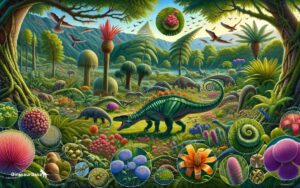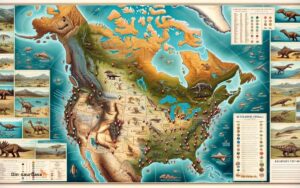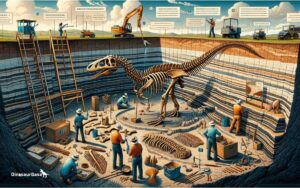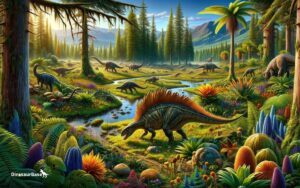Comparing Achelousaurus Vs Triceratops: Detailed Guide
Achelousaurus and Triceratops are distinct ceratopsian dinosaurs, with notable differences in horn and frill structure. The Achelousaurus had a smaller nasal horn and two parietal horns, while Triceratops featured a large nasal horn and two long brow horns.
Dinosaurs have always captivated the imagination, and among the diverse cast of Cretaceous characters, Achelousaurus and Triceratops stand out. These horned dinosaurs, or ceratopsids, roamed North America, but despite some common ancestry, they differed remarkably. Both species wielded impressive frills and horns, yet their distinctive cranial features served as their trademark identifiers.
The Achelousaurus, named after the Greek river god, bore a unique, almost-absent nasal horn and smaller parietal horns, which may suggest a different defensive strategy or display function from that of the more robust and possibly aggressive Triceratops. Understanding their anatomical differences not only paints a clearer picture of their lifestyles and behaviours but also provides insight into the rich diversity that once flourished in ancient ecosystems.
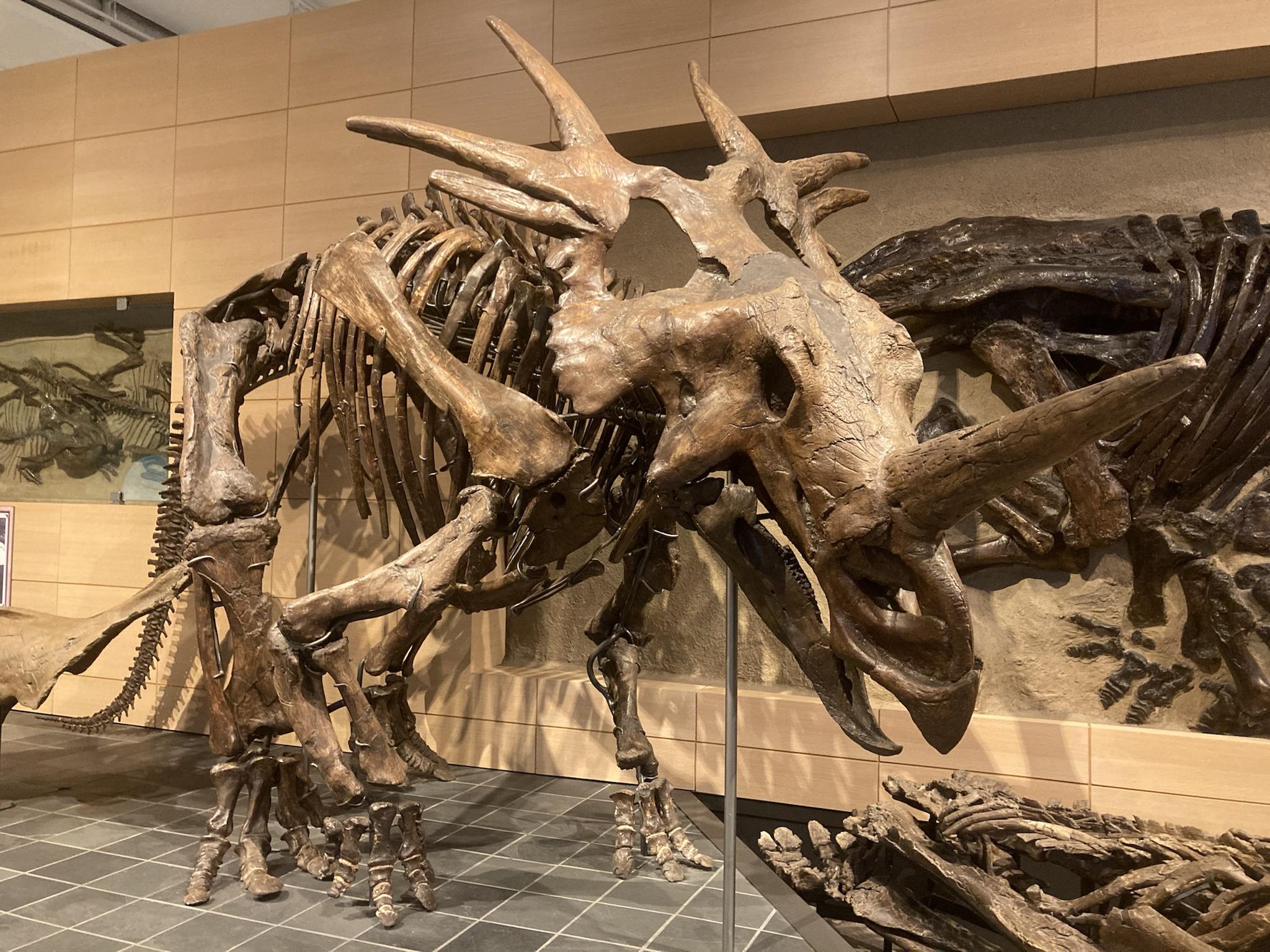
Credit: en.wikipedia.org
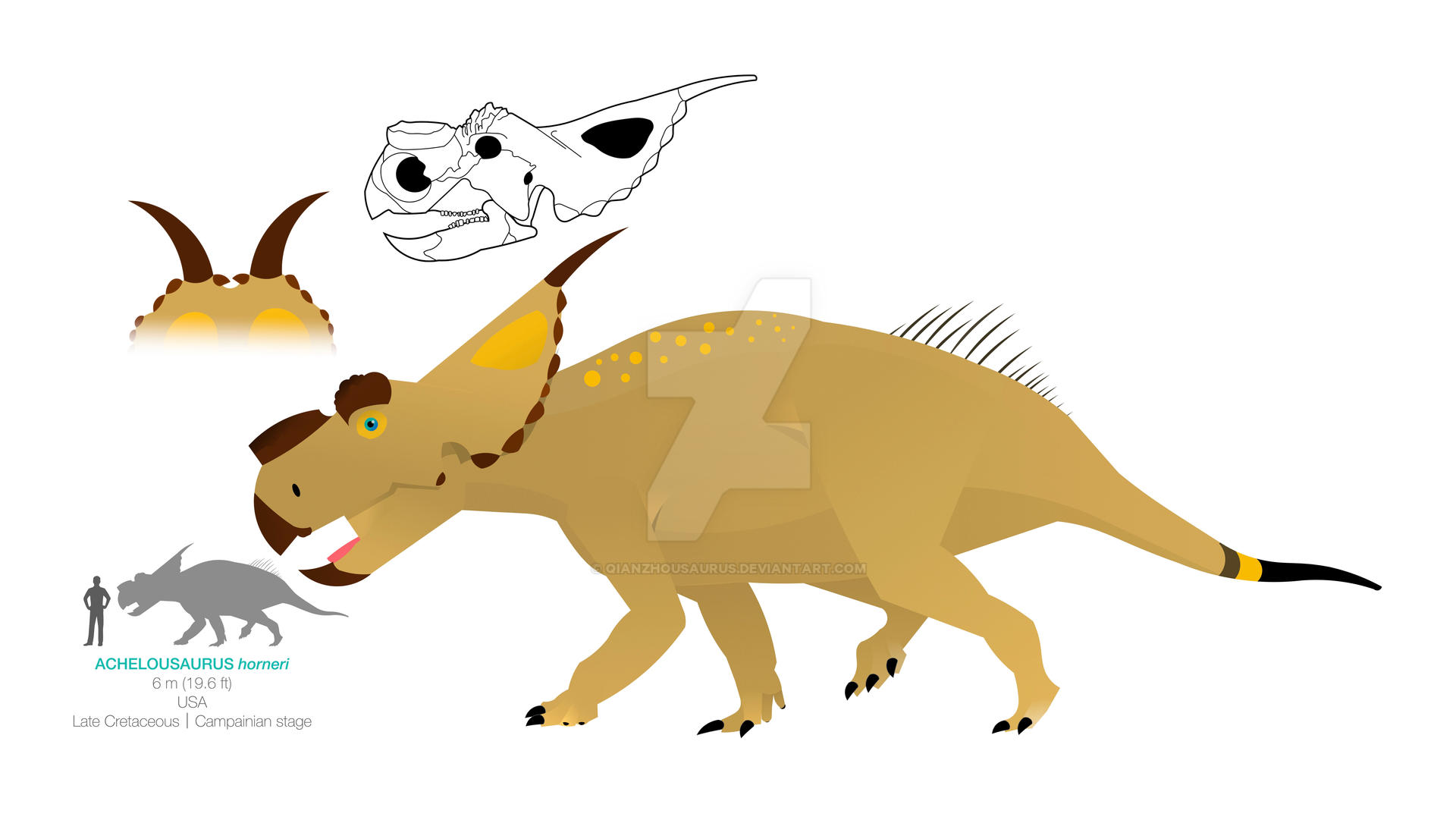
A Glimpse Into The Cretaceous Period
The Cretaceous Period was a time of colossal beasts and verdant landscapes. This era gave rise to some of the most iconic dinosaurs, including the horned giants Achelousaurus and Triceratops. Let’s dive into the lives of these ancient creatures and unravel their world.
The Habitat Of Ancient Giants
The Cretaceous Period was known for its vast and varied habitats. Achelousaurus and Triceratops roamed lands with lush vegetation and diverse ecosystems. Vast forests, rivers, and coastal plains provided abundant food and shelter for these herbivores.
- River Valleys: Offered water and soft plants for eating.
- Coastal Plains: Home to a wide array of vegetation.
- Thick Forests: Provided coverage and broad-leafed plants.
Time Periods Of Dominance
Dinosaurs like Achelousaurus and Triceratops had specific eras where they thrived.
| Dinosaur | Timeframe |
|---|---|
| Achelousaurus | Late Cretaceous, about 74 million years ago |
| Triceratops | Late Cretaceous, about 68-66 million years ago |
Achelousaurus appeared first, stomping through ancient landscapes. Triceratops followed, becoming one of the last-standing dinosaur species before the mass extinction. These giants were true emblems of the Cretaceous’s last chapters.
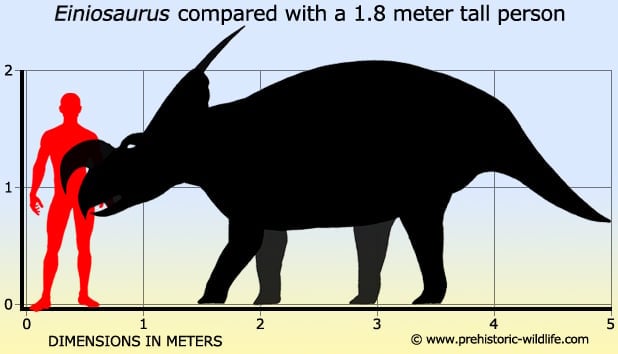
Credit: www.prehistoric-wildlife.com
Unearthing Achelousaurus
Picture a time when giant beasts roamed Earth. One such fascinating creature etched into history is Achelousaurus. It’s a lesser-known but remarkable dinosaur, often compared to the famous Triceratops. Let’s dig into the world of Achelousaurus and see what made it unique.
Discovery And Nomenclature
The tale of Achelousaurus begins with its discovery. Let’s explore:
- Found in: Northwestern Montana, USA.
- Year: 1987.
- Described by: Paleontologist Scott Sampson in 1995.
Its evocative name, Achelousaurus, pays tribute to Greek mythology. Achelous, a shapeshifting river god, had horns much like this dinosaur. The species name adds “saurus,” meaning “lizard.”
Physical Characteristics And Peculiar Features
Achelousaurus had distinct traits that set it apart:
| Feature | Description |
|---|---|
| Size | Up to 20 feet long. |
| Horns | Two stubby horns above the eyes; nose horn reduced or absent. |
| Frill | Large and bony, with two parietal fenestrae (holes). |
| Beak | Sharp and edgy for slicing plants. |
This unique blend of features differentiates Achelousaurus from other horned dinosaurs.
Feeding Habits And Ecological Niche
Achelousaurus was a herbivore, munching on:
- Ferns and moss.
- Cycads.
- Flowering plants that were around at the time.
The environment was diverse, requiring Achelousaurus to adapt. Its role combined being a tough browser and a flexible forager, ensuring survival.
Its strong beak and teeth crushed even the toughest vegetation. This specialization allowed it to thrive alongside the better-known Triceratops.
Triceratops: The Iconic Three-horned Dinosaur
Triceratops, one of the last and greatest dinosaurs, emerged from the mists of time. With its large, bony frill and three distinct horns, Triceratops has captured hearts and imaginations for generations. This iconic dinosaur once roamed the late Cretaceous plains, leaving behind a legacy engrained in modern culture. Let’s delve into the details of Triceratops, the iconic three-horned dinosaur.
First Discovery And Name Origin
In 1887, Othniel Charles Marsh ignited the scientific community with a remarkable find. He found a skull that boasted three striking horns and a large bony frill. “Triceratops”, meaning “three-horned face”, fittingly became its name. This name echoes its most distinct features and establishes its uniqueness among dinosaurs.
Anatomy And Distinctive Traits
Triceratops stood out with an impressive build. Its sturdy frame supported a large skull, which could grow up to 2.5 meters (8 feet) in length. The horns and frill, not only defining features but were likely used in defense and courtship rituals. The body, massive and quadrupedal, bore the weight of this enormous head.
- Skull length: Up to 2.5 meters (8 feet)
- Body: Sturdy, quadrupedal
Dietary Patterns And Role In The Ecosystem
Triceratops fed on low-lying vegetation, thanks to their beaked mouths. Plants like ferns, cycads, and palms were their main food. These massive herbivores played a crucial role in their ecosystem. They shaped their environment by controlling plant growth and serving as prey for predators. Their existence proved vital to the late-Cretaceous ecological balance.
As a keystone species, their impact was profound:
- Helped regulate vegetation growth
- Served as a food source for large carnivores like Tyrannosaurus rex

Credit: www.amazon.com
Comparative Analysis Of Achelousaurus And Triceratops
Venturing back into the Late Cretaceous period, the mighty dinosaurs known as Achelousaurus and Triceratops roamed the Earth. Both members of the ceratopsid family, these prehistoric creatures raise curiosity and debate among paleontologists and enthusiasts alike. This section dives into their differences and similitudes, revealing what set these ancient giants apart.
Skulls And Horns: A Structural Comparison
On first glance, the skulls of Achelousaurus and Triceratops display distinct horn arrangements. The Triceratops, famous for its three sturdy horns, bears a close resemblance to the modern rhinoceros. Its large frill served as a shield. In contrast, Achelousaurus presents with two prominent horns above the eyes and a smaller nose horn, which is believed to have evolved differently over time.
Size And Build: Weighing The Giants
Size mattered in the days of the dinosaurs. The Triceratops stood out for its massive build, reaching lengths of up to 30 feet and weight estimates of 6 to 12 tons. Achelousaurus, slightly smaller, was nevertheless a formidable presence, with a length of around 20 feet and an estimated weight of up to 5 tons. Both beasts carried the weight of their heavy skulls and robust bodies with powerful, quadrupedal stances.
Defense Mechanisms: Battle Of The Brows
The frills and horns of these creatures were not just for show – they were crucial defense mechanisms. Triceratops could have charged predators with its strong horns, while the shorter horns of Achelousaurus may have been used in shoving matches with rivals. Their expansive frills also provided protection for the neck and possibly even acted as a display to intimidate foes or to attract mates.
Interpreting Fossil Records
Unearthing the secrets of the prehistoric world requires a deep dive into fossil records. These remnants of the past give us insight into the fascinating creatures that once roamed our planet. Among the most captivating are the Achelousaurus and Triceratops, two ceratopsians with distinct features. Understanding their lives and appearances hinges on interpreting their fossil clues correctly.
Methods Of Studying Ancient Fauna
Scientists employ various techniques to study these ancient beings. Below are pivotal methods used:
- Comparative Anatomy: Examining similar bones across species.
- Radiometric Dating: Identifying fossils’ ages using radioactive isotopes.
- CT Scanning: Peering inside fossils without damaging them.
- 3D Modeling: Creating digital replicas for further analysis.
Challenges In Reconstructing Accurate Appearances
Despite technological advances, reconstructing ancient creatures poses challenges. Key hurdles include:
- Decomposition: Soft tissues seldom fossilize, obscuring details.
- Erosion: Weathering can erode and distort fossils over time.
- Fragmentation: Incomplete fossils make full reconstructions speculative.
- Plate Tectonics: Continental shifts can scatter and deform fossils.
Tools like digital simulation assist in overcoming these challenges, but some uncertainty always remains.
Significance In Paleontology And Pop Culture
Achelousaurus and Triceratops roamed our planet millions of years ago. These dinosaurs have left a rich legacy for paleontology. Their tales also spread into the realm of pop culture. Let’s uncover their importance.
Impact On Scientific Theories
Achelousaurus and Triceratops give clues about ancient ecosystems. They reveal how dinosaurs adapted. Each discovery shifts our understanding of evolution.
Portrayal In Media And Literature
Both dinosaurs star in books and movies. Triceratops, for instance, frequently appears in blockbuster films. It captures the imagination of audiences. Achelousaurus might be less known. Yet, it also contributes to the dinosaur narrative. This visibility keeps them alive in popular culture.
| Dinosaur | Significance in Paleontology | Significance in Pop Culture |
|---|---|---|
| Achelousaurus | Shows diversity in ceratopsians | Largely unknown but growing in interest |
| Triceratops | Icon for dinosaur research | Popular in movies, shows, and toys |
Dinosaurs” fascinate people worldwide. Achelousaurus and Triceratops serve as important pieces of the puzzle. They deepen our knowledge of the past. Their stories thrill in cinemas and books. This keeps their legacy strong even today.
Frequently Asked Questions On Comparing Achelousaurus Vs Triceratops: Detailed Guide
What’s The Difference Between A Torosaurus And A Triceratops?
The primary difference between Torosaurus and Triceratops lies in their frills. Torosaurus had a larger, thinner frill with two big holes, whereas Triceratops had a smaller, solid frill. This distinction has stirred debate among paleontologists about their classification and potential relationship.
What Distinguishing Features Did The Triceratops Have?
The Triceratops featured three distinct horns, a large bony frill, and a massive body among the late Cretaceous herbivores. Its beak-like mouth adapted for shredding plants.
What Is The Difference Between A Styracosaurus And A Triceratops?
The Styracosaurus has a single large nasal horn and multiple long spikes radiating from its neck frill, while the Triceratops features two large brow horns and a smaller nasal horn, with a shorter, smoother neck frill.
What Is The Difference Between A Zuniceratops And A Triceratops?
Zuniceratops was smaller and older than Triceratops, featuring only two brow horns and a more primitive frill. Triceratops had three facial horns and a larger, more elaborate frill.
Conclusion
In summing up the fascinating face-off between Achelousaurus and Triceratops, we’ve uncovered key differences and intriguing similarities. Exploring their habitats, diets, and defense mechanisms enriches our understanding of these prehistoric giants. With captivating tales etched in fossil records, both species continue to mesmerize paleontology enthusiasts and casual learners alike.
Remember, each dinosaur’s legacy offers a glimpse into Earth’s vibrant evolutionary tapestry.

